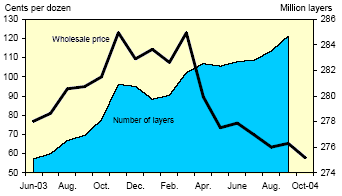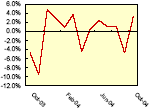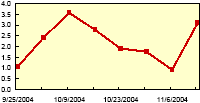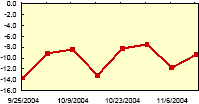



Poultry Outlook Report - November 2004
By U.S.D.A., Economic Research Service - This article is an extract from the November 2004: Livestock, Dairy and Poultry Outlook Report, highlighting Global Poultry Industry data. The report indicates that the Broiler Q4 production forecast is higher than expected and turkey prices are also expected to remain higher.
|
Composite Broiler Price
Percent change from previous month 
|
Broiler production in fourth-quarter 2004 is forecast at 8.6 billion pounds, 4.4 percent higher than a year ago. Higher production is expected to come from an increase in the number of birds slaughtered and higher average weights. U.S. broiler exports for the third quarter of 2004 were 1.25 billion pounds, up 6 percent from a year ago. The export estimate for fourth-quarter 2004 was increased to 1.23 billion pounds, due to lower prices for most broiler parts, growing exports to major markets, and the reopening of shipments to China. For the same reasons, the export estimate for 2005 was raised to 4.96 billion pounds, an increase of over 300 million pounds from the previous estimate.
Wholesale table egg prices (NY grade A large) are expected to average 63-67 cents per dozen in 2005, the lowest price since 1999. The rapid fall of egg prices is due mainly to the quick rise of the U.S. layer flocks and consequently, to increased egg production. As a result, the supply of table eggs rose to a record high, causing prices to tumble. The quick rise in layer numbers was due to the repopulation of laying flocks after a breakout of Exotic Newcastle Disease in the first half of 2003 and favorable producer returns in the second half of 2003 as egg prices rose.
Broiler Production Forecast Higher in Fourth Quarter
|
Wholesale monthly prices (NY grade A large) and egg-type layers during the month

|
Broiler Exports Raised
|
Retail Turkey Price
Percent change from previous month 
|
Third-Quarter Broiler Ending Stocks Higher
Higher broiler production has pushed stocks of broiler products higher during the
third quarter. Broiler stocks held in cold storage at the end of September were 763
million pounds, 27 percent higher than a year earlier. Most of the broiler stocks are
parts and were up 30 percent from the same period in 2003. However, cold storage
holdings of whole broilers were down by 22 percent, which has allowed whole
broiler prices to remain above their year-earlier levels.
The combination of higher production and growing stocks pushed October 2004
prices for most broiler parts below a year earlier. Northeast boneless/skinless breast
meat prices were down 17 percent from a year earlier. Since June, prices for breast
meat products have declined by around 50 percent. However, while their prices
have also declined since June, prices for leg quarters and wings were still 4 and 23
percent higher than a year earlier. With lower stocks available, prices for whole
broilers have been above a year earlier and are expected to remain that way for the
remainder of 2004.
Turkey Production Declines Again
U.S. turkey production in the third quarter of 2004 was 1.39 billion pounds, down 1.6 percent from the same period in 2003. Production decreased as a result of a lower number of birds being slaughtered (down 3.3 percent) offseting an increase in average bird weight to 26.5 pounds. Federally inspected slaughter in the fourth quarter of 2004 is forecast at 1.4 billion pounds, again lower than during the same period in 2003. Turkey production is expected to increase slightly in 2005 in response to higher prices throughout most of 2004.
Turkey Exports for 2005 Increased
The forecast for 2005 turkey exports is now 510 million pounds, up 55 million from the previous estimate. Expected higher shipments to Mexico and Canada and the reopening of the Chinese market are the main reasons for the increase. U.S. turkey exports for third-quarter 2004 were 134 million pounds, up slightly from the previous year, as larger exports to Mexico offset smaller Asian shipments. This places the estimate for annual 2004 exports at 450 million pounds, an increase from earlier estimates but still below the 484 million pounds exported in 2003. The larger shipments to Mexico and some other countries have been the chief reasons for an increase in the export estimate for the fourth quarter to 140 million pounds.
Third-Quarter Ending Stocks Lower
|
Weekly Broiler Slaughter
Percent change from last year 
|
Holdings of turkey parts were also down. Stocks of turkey parts at the end of September were estimated at 237 million pounds, down 12 percent from a year earlier. Total third-quarter ending stocks for turkey were 530 million pounds, a decrease of 118 million pounds (18 percent) from a year earlier.
Turkey Prices Expected to Remain Higher
Lower domestic production and falling stock levels have combined to push whole turkey prices higher over the last 6 months. The price for whole hens in the Eastern region was 76.9 cents per pound in October, up 16 percent (about a dime) from a year earlier. Prices for whole birds and turkey parts are expected to remain strong through the Thanksgiving holiday period and then decline seasonally, but remain above their year-earlier levels. With continued slow production growth and higher exports forecast, turkey prices are expected to remain strong through the first half of 2005.
Egg Prices Continue To Decline
|
Wholesale egg prices (NY grade A large) 2003, 2004, and 1999-2003 average

|
The rapid fall of egg prices was due mainly to the quick rise of U.S. layer flocks and consequently, increased egg production. As a result, table egg production rose to a record high, causing prices to tumble, due to the relatively inelastic price demand for eggs. The quick rise in layer numbers was due to the repopulation of laying flocks after a breakout of Exotic Newcastle Disease in the first half of 2003 and economic incentives from rapidly rising producer returns in the second half of 2003 driven by rapidly rising egg prices. From June 2003 to September 2004, U.S. egg-type layers rose by 9.6 million birds, from 275.1 to 284.7 million egg-type layers. The rapid buildup of the laying flocks brought the U.S. egg-type layers to the largest inventory since 1980 when reporting of separate table egg and hatching flock data began. Table egg production in 2004 is expected to be up nearly 2 percent from 2003. In 2005, table egg production is expected to increase to about 6,400 million dozen, up over 1 percent from 2004.
Turkey Production and Stocks Down, Prices Higher
|
Weekly Turkey Slaughter
Percent change from last year 
|
Retail egg prices dropped to $1.23 in the third quarter of 2004 from $1.42 per dozen in the previous quarter. For all of 2004, retail egg prices are expected to average around $1.35 to 1.37 per dozen, which would be a record high.
In the third quarter of 2004, U.S. egg exports are expected to reach 48 million dozen, up substantially from the first quarter’s 23.2 million. The increase is mainly due to recovery of most U.S. flocks from outbreaks of Avian Influenza in early 2004 and many countries lifting restrictions on U.S. eggs and egg products. For example, U.S. exports of eggs and egg products (in-shell egg equivalents) to the United Kingdom rose from 224,000 dozen to 3.3 million dozen between January and August 2004. Likewise, U.S. exports to Hong Kong rose from 464,000 dozen to 1.9 million dozen and those to China from 27,000 dozen to 927,000 dozen.
The U.S. export market for shell eggs and egg products looks promising in the future, due to competitive U.S. prices, high quality, and several restrictive measures imposed on layer flocks in the European Union due to contaminated feed. Egg exports in 2005 are expected to be about 10 percent higher than in 2004.
Links
For more information view the full Livestock, Dairy and Poultry Outlook - November 2004 (pdf)Source: Livestock, Dairy and Poultry Outlook - U.S. Department of Agriculture, Economic Research Service - November 2004








